On September 13th, 2025, we (EA France) hosted the EA Summit: Paris, in a very central location in the French capital. This event was part of the international series of EA Summits funded by the Centre for Effective Altruism.
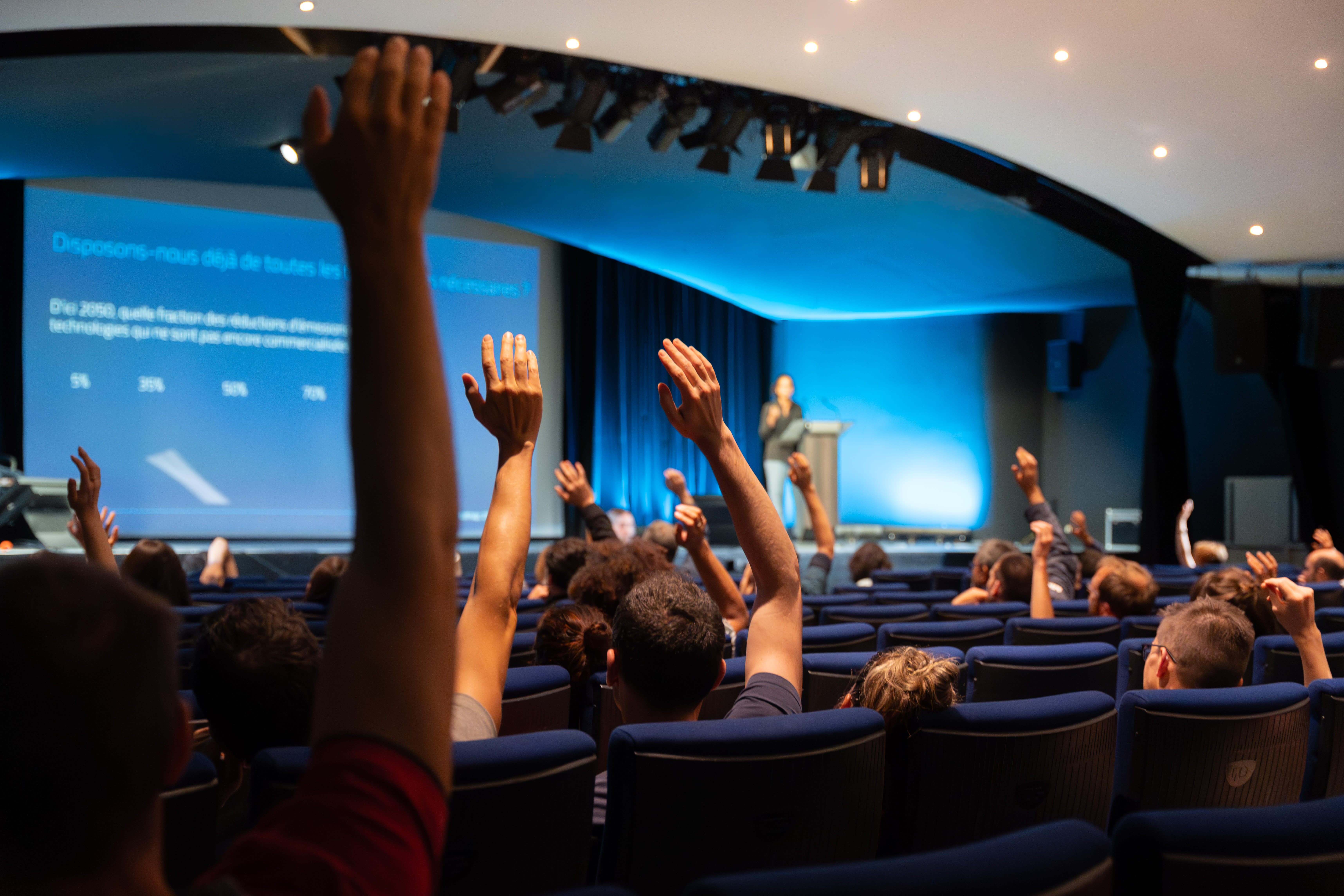
This report outlines what went well, what we could improve, and the lessons we learned, with the hope that it can serve as a resource for others planning similar events.
Key facts and figures
- 217 participants (including volunteers) checked in, along with 20 speakers and 3 photographers/filming crew members, totaling 240 attendees (largest EA Summit to date)
- How familiar were the participants with EA?
- When RSVPing, 89% declared at least “some familiarity, even though I couldn’t clearly define EA”, and 41% declared at least “really familiar, I’ve spent a lot of time thinking about effectiveness and within the community”.
- From experience, we think that many people overestimate their own understanding of EA.
- How familiar were the participants to EA France’s staff?
- Half the participants were completely unknown to the organizers (which does not mean they were all new to EA).
- How familiar were the participants with EA?
- 12 sessions covering global health, climate change, animal welfare, AI risks, nuclear security, and more
- 15 organizations participated in our “projects fair”
- Over 25 volunteers helped with various aspects of the event.
- Budget: Expenses ~€40K, ticket revenue ~€4K => €36K
- Average participant “overall satisfaction”: 6.1/7
- No obvious short-term effects (fellowships, etc.)
Some lessons learned
- The event brought a more diverse crowd than our usual events in terms of age and occupations (more people around retirement age, fewer students).
- Gender diversity and ethnic diversity, however, remain challenges that continue to require specific efforts.
- Such large events provide both external visibility and internal cohesion to the local community.
- Programming: Some more focus on EA’s past achievements would have been beneficial in making a more compelling case for the movement as a whole.
- The event put significant strain on EA France’s staff time, roughly 25% more than we expected. Involving mentors and panel facilitators requires time and energy. The surge of activity extends well beyond the event date, as it generated some work and follow-up actions for EA France.
- Tentative conclusions:
- Overall, we are happy we ran this EA Summit.
- The event in itself went very well: no major hitch, very positive feedback from participants, and anecdotal evidence of effects of varied natures.
- However, the impact on our core metrics has been positive but slightly disappointing so far. The most significant impact might be a rather difficult-to-track, intangible “EA-brand-strengthening” effect.
- Therefore, cost-effectiveness is difficult to calculate.
The rest of this document aims to provide more information about how we prepared and ran the event, as well as some figures about the costs and results.
Context
The EA movement has a growing community in France, with a significant presence in Paris. We currently have 1,500 subscribers to our newsletter, 140 active participants in our Slack, and our yearly, national retreats gather more than 60 participants. We have 1.6 full-time paid community builders for the entire country. Until recently, there was just one book on EA published in French (Peter Singer’s The Most Good You Can Do, known as L’altruisme efficace in French).
Given these circumstances, the Summit aimed to:
- Improve understanding of EA ideas among those vaguely or not familiar with EA principles.
- Encourage involvement through effective donations, career decisions, and exploration of high-impact opportunities.
- Improve the visibility of EA (and EA France) in France.
Therefore, while EAG(x) events usually optimize for the “number of new useful connections”, we wanted this event to be more introductory, less about networking and more about improving epistemics and the understanding of EA principles. Notably, the program was entirely in French.
Preparation phase
Venue
Finding an affordable venue in central Paris for ~250 people was challenging. After a thorough search, we found a venue that proved to be an excellent choice overall, offering a prime location, ample space, and high-quality facilities. (Although it came with a host of–mostly–minor logistical challenges, including limited seating, less-than-perfect signage for bathrooms, some distance between the two main rooms…).
Communication and advertising
- We created an official web page on EA France’s website and featured a banner to inform all visitors.
- Our sources for RSVPs were multiple. Word-of-mouth, our existing newsletter, adjacent communities, and past event participants were the main contributors.
- Approximately 35 people visited CEA's webpage, with 25 checking in.
- We spent €456 on ads via LinkedIn and Instagram, which got us dozens of thousands of “impressions” and hundreds of visitors to the events page. But nobody mentioned ads in their application to the Summit as “how they heard about the event”. They perhaps contributed somewhat to awareness, but were clearly not a significant factor in attendance.
- We invested in a professional design for the event’s branding, and we are very pleased with the result:
Huge thanks to Jess Austin for the fantastic result.
Miscellaneous details
- We chose to charge participants a fee to reduce the likelihood of no-shows.
- The default price was €20, with flexibility to adjust upwards or downwards, and a minimum fee of €5.
- There was also an option for participants to waive the fee.
- ~23% of RSVPs didn’t show up.
- Many people (~10% of the final count) wanted to RSVP in the last 48 hours before the event. We were able to allow some of them in, but not all. It’s also likely that even more people were interested and did not bother to reach out when they saw that applications were closed.
- People who paid less, or even those who paid €0, were not more likely to miss the event.
- In total, we collected €3,978, which covered 9.9% of the event's expenses.
We also produced branded merchandise (reusable cups, shirts, tote bags, notebooks, stickers –€2500 in total)[1].
These seemed appreciated on site, but we did not ask about this in the feedback form.
We hope this will have a “brand-building” effect (which is why many companies use merchandise), but this impact can only be slow and is impossible to track at our scale (except for potential anecdotal evidence).
Involving merchandise incurs costs, as well as logistical efforts, including color and design choices, materials, printing, payment, and storage.
How the event went
A few weeks before the event, we feared we might have to cancel it because of a potentially massive, country-wide strike that could interrupt public transport. Fortunately for us, the strike was over 2 days before the Summit, allowing speakers from other regions to join us in Paris. Still, it is a good reminder that external events can severely affect our work and impact (the Summit in the Philippines 2 weeks later was canceled because of dangerous weather).
A few notes on how it went:
The Summit covered a wide range of topics, featuring conferences and panels[2]* on global health, climate change, animal welfare, AI safety, and nuclear risks (program in French here). For lack of speakers with a good grasp on EA principles, we were unable to include biorisks in this programming (although it was briefly presented in overview talks).
- It is difficult to say how many people attended which sessions because there was no pre-registration. Half of the sessions were recorded, and many participants realized they could watch them later; this makes it impossible to conclude about the respective appeal of the sessions. According to our feedback form (which naturally involves a strong selection bias), the most attended sessions were the intro talk about “What EA is – and isn’t” and the panel about AI Safety. Most sessions were attended by 40 to 80 people.
- We did not use Swapcard or any other event platforms.
- Slido proved to be an effective tool for interactive Q&A sessions
- Our Notion-made page of information was shared before the event and during the event with a QR code.
- We think that the combination of these two tools was a good replacement for Swapcard, which we did not want to force our public to install. Still, some people specifically interested in networking (and EAs used to Swapcard) suggested that Swapcard would have done a great job connecting them with other participants.
- More than a dozen organizations were tabling during the High-Impact Projects Fair at noon
- All the “usual” cause areas were represented
- We tried to platform France-based projects. Fortunately, Ambitious Impact, Future Cleantech Architects, and the Happier Lives Institute were all able to send representatives to this fair.
- Some organizations told me they could have prepared better to maximize the benefits of this opportunity. We did send out recommendations but could have been more insistent.
- The closing session, “Now it’s time to act,” was very well-received. In it, I encouraged participants not to let these ideas remain theoretical, but to take action in their own lives, even if it meant thinking in the medium- or long-term, using personal stories (including mine) and a humorous tone. This format seemed to resonate strongly with the attendees, and I’d recommend future Summit organizers consider a similar approach. (here are the slides; this session was not recorded.)
- Late arrivals: Many attendees arrived late and/or didn’t stay for the whole day.
- Speed meetings:
- The two speed-meeting sessions were underattended, even though there was only one competing session in parallel. The fact that many exhibitors lingered in the central zone the whole afternoon did not help.
- The recommended format was a bit rigid, and the instructions were complex for “mentors”/facilitators who could not spend much time preparing for these sessions. If we had to do it again, we would try to encourage more natural conversations (while still providing guidance to facilitators) in groups of flexible sizes.
- Demographics:
- Attendants were predominantly male (almost 63% according to the feedback form). This is fairly average compared to other EA events.
- Although we did not conduct a survey, an overwhelming majority (approximately 90% or more, possibly 95%+) of attendees were white.
- These correspond roughly to the typical demographics we see at our events.
- We saw more diversity in terms of age: there was a ~4-year-old kid with her mom, and more than a few people who were retired. 13% of the respondents in the feedback form were over the age of 45.
- Two thirds of respondents were from the Paris region.
- Occupational Breakdown:
- Of those who selected a single occupation, 48% were “employed,” 23% were “entrepreneurs,” and 14% were “looking for a job.”
- Remarkably, only 3.9% described themselves as “students”.
- Volunteers: We had an impressive crew of volunteers, who were conspicuous thanks to our blue T-shirts. Participants praised the warmth and helpfulness of this fantastic bunch, as well as the professionalism of the logistics.
We are immensely grateful as well.
- We had a photographer and film crew on site, which we expect will be valuable for future marketing and outreach. About 15 people and organizations have shared pictures of their participation on social media, thanks to the high-quality images taken. This was costly, but such visuals are typically effective in engaging the community, donors, and potential job applicants.
Results
Feedback from participants
We received 73 feedback responses. Here are two metrics:
- Satisfaction: 6.1/7 on average
- At least 75% of participants rated the sessions as either “positive” or “very positive” (3 or 4 on a [0-4] scale).
- Impact on participant sentiment toward EA: There was a remarkable increase in participants' enthusiasm and engagement with EA.
Did your opinion on EA improve or worsen due to the Summit? (4 = not improved nor worsen, 7 = improved a lot)
Impact on the popularity of EA France’s activities: limited
It is interesting to examine whether our activities and channels have experienced an uptick in activity around the Summit.
- Slack:
- Newsletter subscriptions: very small effect (a handful more subscribers than usual)
- 1-1 requests: limited effect (a few more requests than usual)
- Website traffic: strong effect
- Fellowship applications: limited, positive effect (a few more requests than usual)
- EA Paris social events attendance: limited, positive effect (a few more requests than usual)
- Applications to our national retreat (6 weeks after the summit): slightly negative effect (we can hypothesize that the two events were a bit too close).
- We were able to send 18 people to High-Impact Professionals (all those who said they were interested in being listed on HIP’s directory).
| Metrics | Short-term effects |
| Activity and newcomers on Slack | Small positive effect |
| Newsletter subscriptions | Very small positive effect |
| 1-1 requests | Small positive effect |
| Website traffic | Strong positive effect, but temporary |
| Fellowship applications | Small positive effect |
| EA Paris social events attendance | Small positive effect |
| Applications for our national retreat | Small negative effect |
| Registration on High-Impact Professionals | Positive effect |
Impact on the existing community
Several attendees shared that they felt proud to be part of something so impactful and capable of gathering so many cool people. They felt it made it much easier to take our own efforts seriously. Senior speakers seemed impressed by the event’s scale and organization. Some of them expressed gratitude for the opportunity to be part of this.
This large event seems to have boosted pride and cohesion in the local EA community.
In summary, the immediate impact on our usual activities seems limited. However, it seems plausible that most of the event’s value stems from its contribution to “the EA brand”, which in turn triggers donation or career changes over the long run. But it is very hard to track.
It might also be the case that such Summits serve the existing community (even in hard-to-quantify-or-even-notice ways) and help people stay engaged, motivated, and connected just as much as they help people discover EA.
Costs
Expenses break-down
Participants' contribution covered about 9.9% of the event expenses.
Time costs
I estimate that the project took (very roughly) ~478 paid hours to complete (we’d planned 400h). These hours were paid in good part (€ 8,410, see table above) by the grant from CEA’s Events team. The rest was integrated into EA France’s annual expenses.
The people who were paid to do work on this were project manager Thibaud and EA France staff (Guillaume, Capucine, Solal). Providing a breakdown of these hours is really difficult, overall there were many hours spent on every stream: finding a venue, programming, communication, logistics, reporting.
The table above doesn't include the many hours spent by volunteers who helped us ahead of the event (dozens of hours) and during the event (100h+)! Thank you so much!
Acknowledgments
This event was only possible thanks to:
- Volunteers (including multiple EA France board members) who worked a lot before and during the event.
- Speakers and exhibitors for their expertise and inspiration.
- The Centre for Effective Altruism for their ongoing support.
- The participants, who made the event come alive.
- The staff, permanent or hired, at EA France.
We are deeply grateful to all of you.
We hope these insights will help others planning similar events. If you’re organizing a comparable Summit, feel free to reach out or share your comments, questions and experiences in the comments!
Many thanks to Alix Pham, Antonin Broi, Arthur Malone, Madeleine Amiel-Jourdaa, and Tom Dugnoille for their help reviewing this report. Mistakes are my own.
- ^
For the first time since EA France was created.
- ^
Yes, we were aware of this excellent piece and took its recommendations to heart.

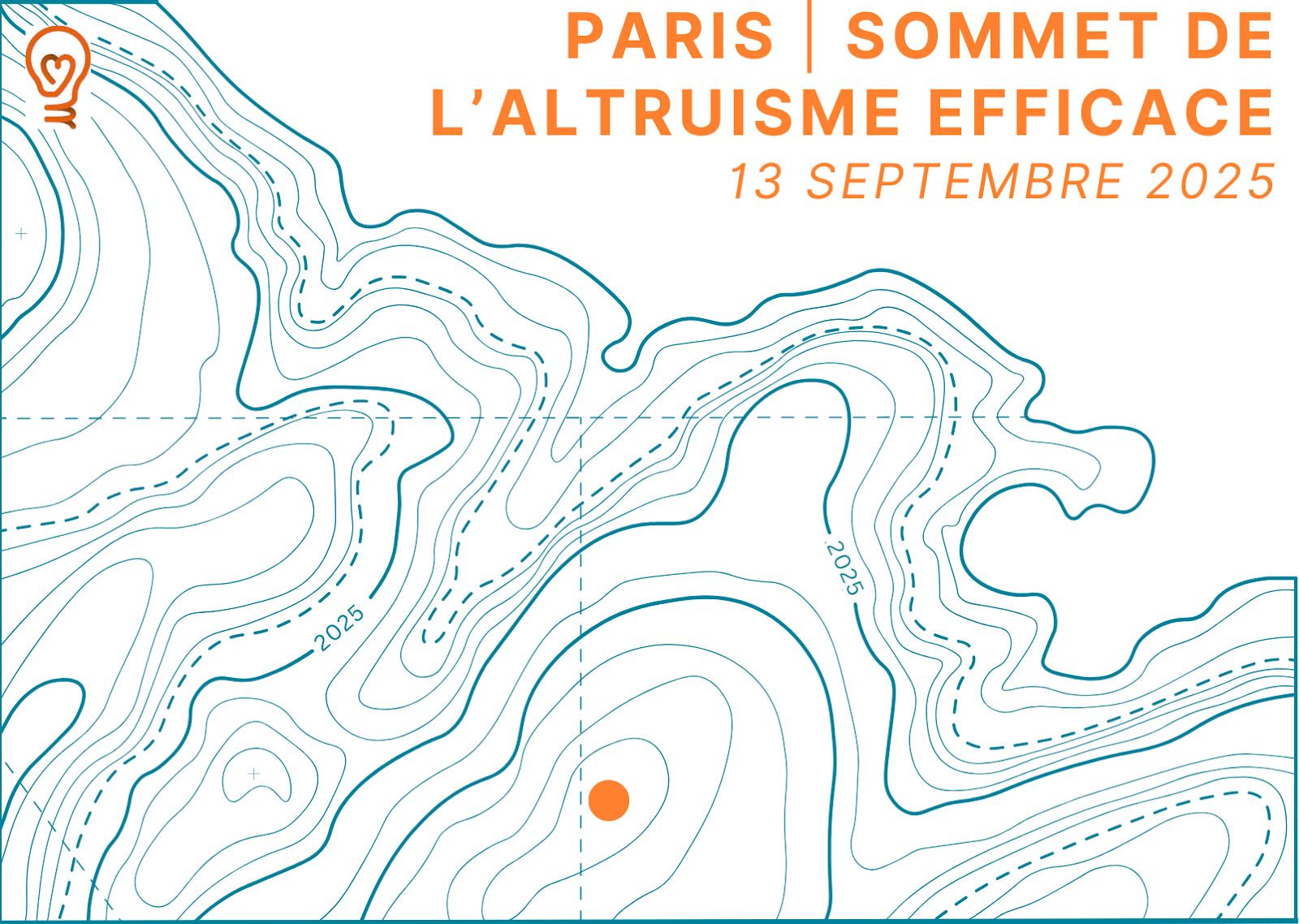
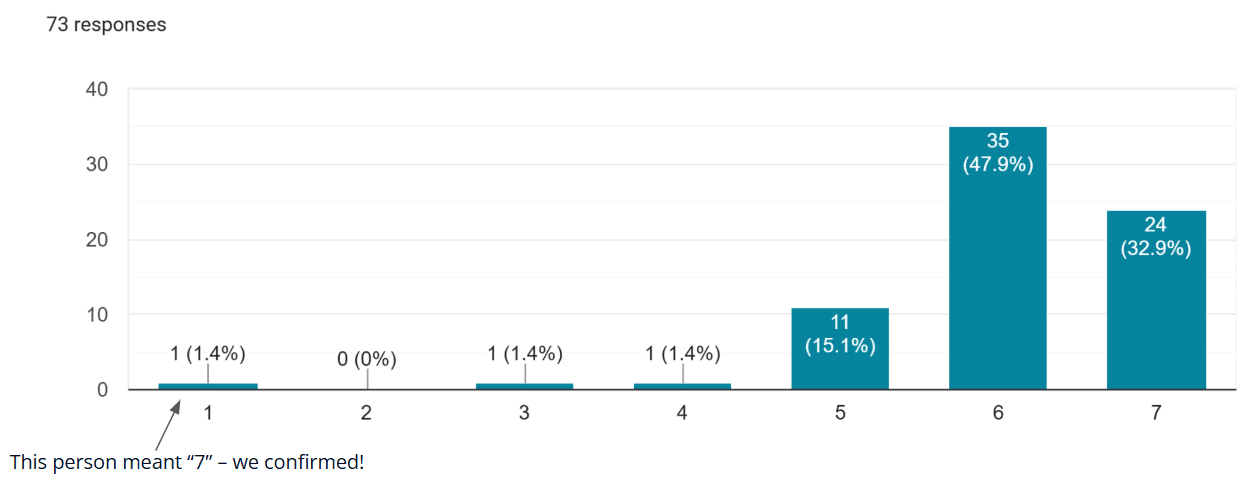



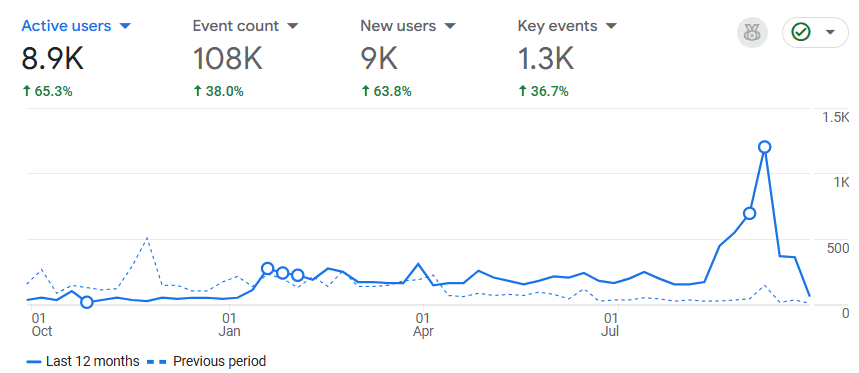
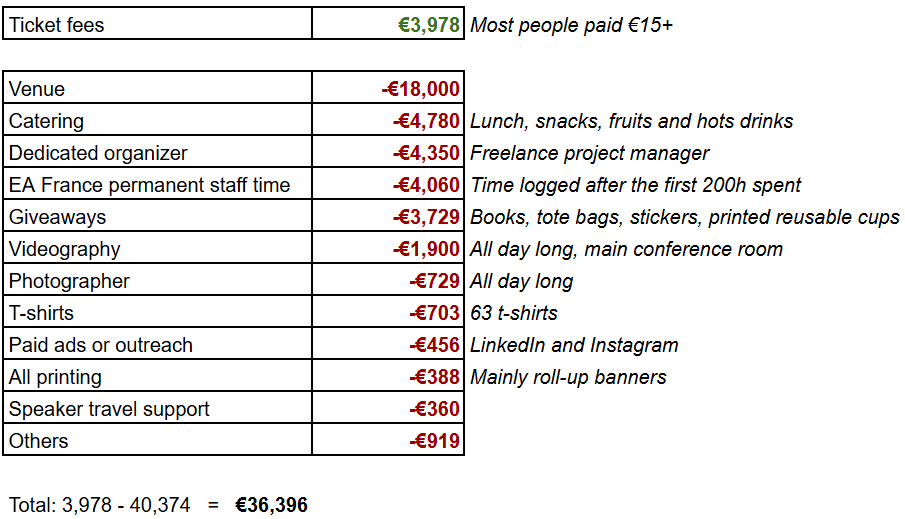
Really cool! Love these breakdowns that go into the weeds of measurable impact.
"Programming: Some more focus on EA’s past achievements would have been beneficial in making a more compelling case for the movement as a whole."
I intuitively agree ("track record" seems like one of the strongest arguments for EA (obligatory Scott Alexander reference), especially in global health and farm animal welfare), but I wonder what makes you say that. Was it something you heard in the feedback form?
Thanks for the kind words!
To answer your question:
- One person said it to me, and another wrote it in the feedback form: it can be hard to understand how an organization can amend their activities to be more effective, concretely. Another person found the event "too theorical".
- I personally think examples contribute a lot to making the ideas clearer and more convincing.